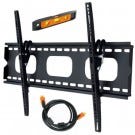One of the great benefits of having a slimline flat screen television is the ability to mount it on the wall. There are a couple of things you need to do before buying your bracket. You will need to know the size and weight of your television. You will also need to see what the mounting pattern at the back of your TV is as this will also determine which bracket to use. Once you have determined the size, weight and hole pattern of your television, you will need to determine the function you need from your bracket. Do you want it fixed, tiltable or full motion. (See our blog on bracket types)
So now you’ve got your bracket, here are the next steps to mount your TV.
The Video & Electronics Standards Association (VESA) sets standards for electronic visual displays. One of VESA standards determines mounting hole patterns. Hole patterns are found on the back of your television and are used for attaching your bracket to the wall. Essentially the standard determines the size and hole pattern at the back of your tv, which should match the hole options on brackets.
1. Find the wall studs within the wall. Do not just mount your bracket to the plaster wall, as it will not be strong enough to hold your television and will be in danger of falling off the wall. The best way is to use a stud finder, cheaply available at most hardware stores. Mark where the centre of the stud is with a pencil on the wall. You must firmly screw into two solid studs, with 4 fixings (2 per side).
2. Decide how high you would like to mount your television, keeping in mind that the best height is usually eye height when sitting in a viewing position, but this is really up to your own personal preference. Then, using the VESA holes in both your bracket and television, measure the distance vertically and mark with a pencil on the wall, running up and down the stud.
3. Screw into the holes vertically. You will need to check that the bracket is level, by resting a spirit level on the top of the bracket. Many brackets have built in spirit levels, conveniently giving you a permanent visual reference. Once the vertical screws are in place, finish with the remaining screws.
4. If you are running your cables through the wall, this is a good time to do it, as you can see clearly before mounting the television. Consider using wall plates or cable management devices to keep everything neat and tidy, because what’s the point in mounting your tv, if the end result is lots of messy cables floating around.
5. Next you will be hanging the television on the mount. It’s a good idea to have someone help you lift the television, because an extra pair of hands will reduce the strain as well as get the placement right, the first time. Screw the television to your mount. Double check both the mount and television are stable and securely fastened. (Don't forget to ensure that each side of the mount is firmly screwed into a stud with 2 screws per side)
6. Now you can connect your cables back into your television and devices, sit back and enjoy your favourite movie or tv show.







